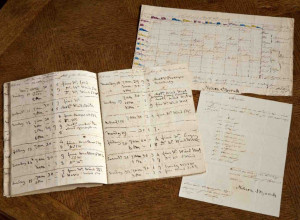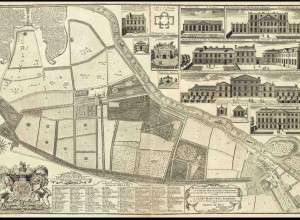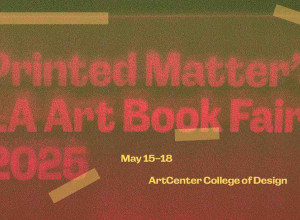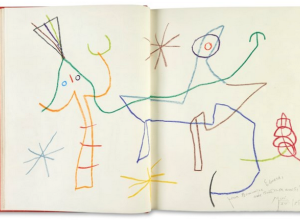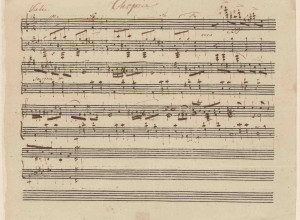Bright Young Librarians: Meghan Constantinou
Our series profiling the next generation of special collections librarians continues today with Meghan Constantinou of the Grolier Club in New York City.
How did you get started in rare books?
I have always felt grounded by objects. As an undergraduate, I majored in studio art and then moved on to working with prints at a commercial art gallery (Childs Gallery, Boston) and museum objects at the Museum of Fine Arts, Boston. I fell in love with rare books while doing my Master's Degree in Art History at the University of Delaware, where my thesis focused on a medieval manuscript. I felt stimulated and challenged by the multi-dimensionality of medieval manuscripts--the manner in which they combined art, penmanship, text, literature, language, and functionality. From there, my interests naturally flowed into printed books. It was actually my advisor who suggested I look into rare book librarianship. Since I had always seen myself as a future museum professional, librarianship had never entered my thoughts. However, as soon as I started exploring the field, I knew immediately that this was the right path for me. Not only would it bring me into regular contact with the types of objects I loved most, but there was a focus on service and outreach that really appealed to me. I also felt liberated by the breadth of special collections work--the promise that I would be constantly exposed to new and different types of things. I started volunteering at the Rosenbach Museum & Library and the Rare Book Department of the Free Library of Philadelphia to learn more about the field. When I moved to New York City to get my library degree, I was fortunate to get a job as Library Assistant at the Grolier Club, which put me in a great position to apply for my current job as Librarian.
What is your role at the Grolier Club? What is a typical day like?
My official title is Librarian. I am responsible for overseeing the day-to-day operations of the Club's research library, which consists of approximately 40,000 general monographs on the history of the book; 150,000 antiquarian bookseller and auction catalogs; 10,000 rare books; 10,000 prints, drawings, and photographs; and 1,500 linear feet of archives and manuscripts. I administrate all of the activities relating to technical services, public service and outreach, and collections management. I also do small library exhibitions and tours on a regular basis, and I am in charge of collection development for our general collection. Since we have a small staff of only three and a half, I am directly involved "on the ground" with all of these activities, which lends the job an endless amount of variety. There is definitely no typical day. One moment I might be engaged in strategic planning, another I might be teaching a class, and another I might be cataloging recent rare acquisitions.
How is it working as a librarian for a private club in comparison to an academic institution?
Working for a private club has been an incredibly rewarding experience. There is a vibrant social aspect to the job that is really unique. Through my work in the library, along with Grolier Club lectures, seminars, and social gatherings, I have had the chance to develop close relationships with many of the members, who embraced me from the start as one of the family. There is a feeling of fellowship, camaraderie, and mutual passion that permeates the Club, and it is exciting to be at the center of it.
Favorite rare book/ephemera that you've handled?
This is a tough one. One of the qualities that characterizes many special collections librarians is our passionate interest in all kinds of "stuff," whether it's a beautifully illustrated incunable or a badly printed broadside. I'm most drawn to objects that have a strong human element. The Grolier Club has a fantastic collection of private library manuscript catalogs that excites me a lot. I like comparing the different organizational schemes, handwriting styles, papers, bindings, etc. You can learn a lot about a person by the way they've organized their books and how they've chosen to physically document them, particularly in the intimate space of a manuscript. I was once updating the cataloging on an attractive eighteenth-century French manuscript catalog that we had recorded only as belonging to "Madame La Vallière." When I checked the title page, I noticed that her honorific, "La Duchesse," had been systematically crossed out. As I did more research, I learned that Madame La Vallière was the wife of the famous bibliophile, Louis-César de la Baume le Blanc, Duc de la Vallière (1708-1780), and that she was arrested during the Reign of Terror on September 11, 1793 at the age of nearly 80. Nobody knows what happened to her after her arrest, but this manuscript survived as part of her story. It gave me a chill.
What do you personally collect?
Recently, I started collecting bookplates designed for women. I am interested in both women's histories and the graphic arts, and bookplates are a perfect combination of the two. I also enjoy biographical research and hope to be able to learn more about the women whose bookplates I have collected. I like looking at the different designs and thinking about the women who commissioned them. Plus, they don't take up too much space in my small New York City apartment!
What excites you about rare book librarianship?
There is a sense of wonder at the core of this work that never ceases for me. I have always been fascinated by how our experience of the world is mediated through the objects that we encounter and create, and rare book librarianship allows me to explore that question in a meaningful way every day. I am also excited by having the opportunity to connect people with objects. There is nothing that beats seeing my own passion for historical objects reflected in the face of a visitor. There is something universally human about the tactility of these books, and in a classroom setting these connections can feel almost palpable at times.
Thoughts on the future of special collections librarianship?
I think a key word for the future is access. Special collections librarians are working hard to dispel the perception that their collections exist under lock and key. The emphasis on access has been facilitated in many ways by new technologies, such as the web and digitization, which allow our objects to perform more dynamically for wider audiences. For many of us, it is no longer enough to simply house and preserve the objects under our care. We have to prove the relevance of our collections to a degree that I suspect is unprecedented, and this is inspiring a lot of creative, out-of-the-box thinking.
Another issue we are grappling with as a profession is the advent of born-digital materials. At the Grolier Club, we are known for our unparalleled collection of antiquarian bookseller and auction catalogs, which provides a valuable primary resource for scholars interested in the history of the book trade. However, much of the material generated by the trade now comes in the form of online catalogs, pdf lists, and dynamic websites. How do we document, archive, and provide access to these new formats in a sustainable way? This is just our version of a larger problem that many special collections librarians are dealing with now on a regular basis.
Any upcoming exhibitions?
I do small library exhibitions three or four times a year, which are open to members and outside researchers visiting the library by appointment. These exhibitions are always drawn from our collections, and give me a great opportunity to explore our stacks and do a little research. Right now, I am showing "Private Press Editions of Chaucer in The Grolier Club Library," from Sept. 9 to Dec. 20, 2013.
However, the Grolier Club also has a very active public exhibitions schedule, and all of those exhibitions are free and open to everyone. In our main gallery, we are showing "Extraordinary Women in Science & Medicine: Four Centuries of Achievement," which explores the legacy of thirty-two remarkable physicists, chemists, astronomers, mathematicians, and medical doctors (Sept. 18-Nov. 23, 2013). After that, we will be showing "Selling the Dwelling: The Books that Built America's Houses, 1775-2000," curated by Richard Cheek (Dec. 11, 2013-Feb. 7, 2014). In our second floor gallery, we are showing, "William Everson: Poet, Printer & Monk, from the Collection of Nicholas Scheetz" through Nov. 1, 2013. Information about all of our exhibitions (past, present, and forthcoming) and related activities may be found on our website.








